Internalization of coxsackievirus A9 is mediated by {beta}2-microglobulin, dynamin, and Arf6 but not by caveolin-1 or clathrin
- PMID: 20089652
- PMCID: PMC2838097
- DOI: 10.1128/JVI.01340-09
Internalization of coxsackievirus A9 is mediated by {beta}2-microglobulin, dynamin, and Arf6 but not by caveolin-1 or clathrin
Abstract
Coxsackievirus A9 (CAV9) is a member of the human enterovirus B species within the Enterovirus genus of the family Picornaviridae. It has been shown to utilize alphaV integrins, particularly alphaVbeta6, as its receptors. The endocytic pathway by which CAV9 enters human cells after the initial attachment to the cell surface has so far been unknown. Here, we present a systematic study concerning the internalization mechanism of CAV9 to A549 human lung carcinoma cells. The small interfering RNA (siRNA) silencing of integrin beta6 subunit inhibited virus proliferation, confirming that alphaVbeta6 mediates the CAV9 infection. However, siRNAs against integrin-linked signaling molecules, such as Src, Fyn, RhoA, phosphatidylinositol 3-kinase, and Akt1, did not reduce CAV9 proliferation, suggesting that the internalization of the virus does not involve integrin-linked signaling events. CAV9 endocytosis was independent of clathrin or caveolin-1 but was restrained by dynasore, an inhibitor of dynamin. The RNA interference silencing of beta2-microglobulin efficiently inhibited virus infection and caused CAV9 to accumulate on the cell surface. Furthermore, CAV9 infection was found to depend on Arf6 as both silencing of this molecule by siRNA and the expression of a dominant negative construct resulted in decreased virus infection. In conclusion, the internalization of CAV9 to A549 cells follows an endocytic pathway that is dependent on integrin alphaVbeta6, beta2-microglobulin, dynamin, and Arf6 but independent of clathrin and caveolin-1.
Figures
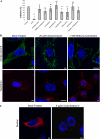
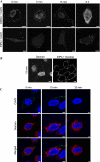
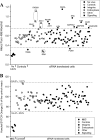
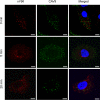
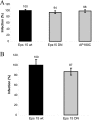
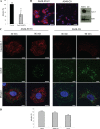
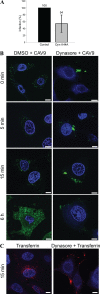

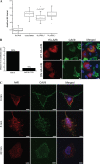
Similar articles
-
Integrin alphaVbeta6 is a high-affinity receptor for coxsackievirus A9.J Gen Virol. 2009 Jan;90(Pt 1):197-204. doi: 10.1099/vir.0.004838-0. J Gen Virol. 2009. PMID: 19088289
-
Integrins are not essential for entry of coxsackievirus A9 into SW480 human colon adenocarcinoma cells.Virol J. 2016 Oct 18;13(1):171. doi: 10.1186/s12985-016-0619-y. Virol J. 2016. PMID: 27756316 Free PMC article.
-
Clathrin- and caveolin-1-independent endocytosis: entry of simian virus 40 into cells devoid of caveolae.J Cell Biol. 2005 Jan 31;168(3):477-88. doi: 10.1083/jcb.200407113. Epub 2005 Jan 24. J Cell Biol. 2005. PMID: 15668298 Free PMC article.
-
Caveolae internalization regulates integrin-dependent signaling pathways.Cell Cycle. 2006 Oct;5(19):2179-82. doi: 10.4161/cc.5.19.3264. Epub 2006 Oct 1. Cell Cycle. 2006. PMID: 16969102 Review.
-
Cellular Uptake Pathways of Nanoparticles: Process of Endocytosis and Factors Affecting their Fate.Curr Pharm Biotechnol. 2022;23(5):679-706. doi: 10.2174/1389201022666210714145356. Curr Pharm Biotechnol. 2022. PMID: 34264182 Review.
Cited by
-
Differential uptake of nanoparticles by endothelial cells through polyelectrolytes with affinity for caveolae.Proc Natl Acad Sci U S A. 2014 Feb 25;111(8):2942-7. doi: 10.1073/pnas.1322356111. Epub 2014 Feb 10. Proc Natl Acad Sci U S A. 2014. PMID: 24516167 Free PMC article.
-
The C-type Lectin Langerin Functions as a Receptor for Attachment and Infectious Entry of Influenza A Virus.J Virol. 2015 Oct 14;90(1):206-21. doi: 10.1128/JVI.01447-15. Print 2016 Jan 1. J Virol. 2015. PMID: 26468543 Free PMC article.
-
Integrins modulate the infection efficiency of West Nile virus into cells.J Gen Virol. 2013 Aug;94(Pt 8):1723-1733. doi: 10.1099/vir.0.052613-0. Epub 2013 May 8. J Gen Virol. 2013. PMID: 23658209 Free PMC article.
-
Identification of β2 microglobulin, the product of B2M gene, as a Host Factor for Vaccinia Virus Infection by Genome-Wide CRISPR genetic screens.PLoS Pathog. 2022 Dec 27;18(12):e1010800. doi: 10.1371/journal.ppat.1010800. eCollection 2022 Dec. PLoS Pathog. 2022. PMID: 36574441 Free PMC article.
-
Canine respiratory coronavirus employs caveolin-1-mediated pathway for internalization to HRT-18G cells.Vet Res. 2018 Jul 3;49(1):55. doi: 10.1186/s13567-018-0551-9. Vet Res. 2018. PMID: 29970183 Free PMC article.
References
-
- Benmerah, A., M. Bayrou, N. Cerf-Bensussan, and A. Dautry-Varsat. 1999. Inhibition of clathrin-coated pit assembly by an Eps15 mutant. J. Cell Sci. 112:1303-1311. - PubMed
Publication types
MeSH terms
Substances
LinkOut - more resources
Full Text Sources
Other Literature Sources
Research Materials
Miscellaneous

